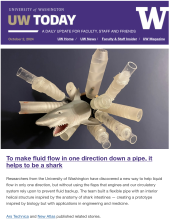Unlike human intestines, which are long, hollow tubes, the intestines of sharks and rays contain interior helical structures surrounding a cylindrical hole. One function of these structures may be to create asymmetric flow, favoring passage of fluid down the digestive tract. Here, we design and 3D print pipes with interior helical structures that are inspired by shark intestines. We print the structures in both rigid and deformable materials. Using the rigid models, we test which physical parameters of the interior helices yield the largest flow asymmetries. These asymmetries exceed those of traditional Tesla valves, structures that are specifically designed to create flow asymmetry without any moving parts. When we print the biomimetic models in elastomeric materials so that flow can couple to the structure’s shape, the resulting flow asymmetry is huge: sevenfold larger than in rigid structures. The ability of scientists and engineers to influence the direction of a flow through a structure has applications in biological tissues and artificial devices across many scales, from large industrial pipelines to small microfluidic devices. This research was covered by the press in articles in Ars Technica, New Atlas, and Phys.Org. The first author, Ido Levin, is a Washington Research Foundation Postdoctoral Fellow in the Keller Lab. Ido was named a Featured Contributor by Wolfram editors of who chose his designs for the printable models as a Wolfram Community Staff Pick.
